

NRF24: NRF24 library for Arduino. This is the Arduino NRF24 library.
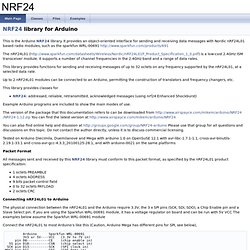
It provides an object-oriented interface for sending and receiving data messages with Nordic nRF24L01 based radio modules, such as the sparkfun WRL-00691 The nRF24L01 ( is a low-cost 2.4GHz ISM transceiver module. It supports a number of channel frequencies in the 2.4GHz band and a range of data rates. This library provides functions for sending and receiving messages of up to 32 octets on any frequency supported by the nRF24L01, at a selected data rate. Up to 2 nRF24L01 modules can be connected to an Arduino, permitting the construction of translators and frequency changers, etc.
This library provides classes for NRF24: addressed, reliable, retransmitted, acknowledged messages (using nrf24 Enhanced Shockburst) Example Arduino programs are included to show the main modes of use. The version of the package that this documentation refers to can be downloaded from You can find the latest version at Packet Format. Arduino - Firmata over nRF24 - Robotics Stack Exchange. I'm having some technical problems...

I'm trying to use Firmata for arduino but over nrf24, not over Serial interface. I have tested nRF24 communication and it's fine. I have also tested Firmata over Serial and it works. Base device is simple "serial relay". When it has data available on Serial, read it and send it over nRF24 network. Node device is a bit complex. Read override id handeled in loop method in this way: while(Firmata.available()) Firmata.processInput(); // Handle network data and send it to Firmata process method while(network.available()) { RF24NetworkHeader header; uint8_t data; network.read(header, &data, sizeof(uint8_t)); Serial.print(data, DEC); Serial.print(" "); Firmata.processInputOverride(data); BlinkOnBoard(50); } currentMillis = millis(); Firmata processInputOverrride is little changed method of processInput where processInput reads data directly from FirmataSerial, and in this method we pass data down to method from network.
There is no response. Arduino-cluster-network - Arduino library for nRF24 based cluster networking. nRF24 Multi-Network – Allowing for 255 addresses. As the nRF24L01 modules are so cheap I bought quite a lot of them and have been thinking about networking them together.
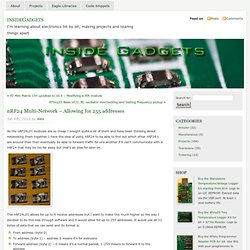
I have the idea of using nRF24 to be able to find out which other nRF24′s are around then then eventually be able to forward traffic for one another if it can’t communicate with a nRF24 that may be too far away but that’s an idea for later on. The nRF24L01 allows for up to 6 receive addresses but I want to make this much higher so the way I decided to do this was through software and it would allow for up to 255 addresses. It would use all 32 bytes of data that we can send and its format is: From address (byte 0)To address (byte 1) – address 0 means it’s for everyoneForward address (byte 2) – 0 means it’s a normal packet, 1-255 means to forward it to the addressAcknowledgement (byte 3) – 0 means no ack is needed, 1 means ack is needed back, 2 is the ack to send back, 3 is the ack to send back when forward is completeData (byte 4 to 31) Transmitter Receiver. RF24Network for Wireless Sensor Networking. RF24Network is a network layer for Nordic nRF24L01+ radios running on Arduino-compatible hardware.
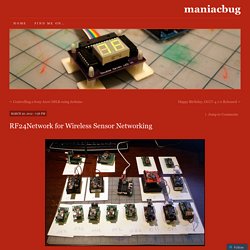
It’s goal is to have an alternative to Xbee radios for communication between Arduino units. It provides a host address space and message routing for up to 6,000 nodes. The layer forms the background of a capable and scalable Wireless Sensor Network system. At the same time, it makes communication between even two nodes very simple. Today, I managed to get 17 nodes running on a single network. Hardware The fastest way to get RF24Network-compatible hardware is to build the Getting Started board, or the ProtoShield board as explained in other posts, attached to commercially-available Arduino. Ultimately, I wanted something smaller, cheaper and more power-efficient, so I built a Low Power Wireless Sensor Node.
Simple Transmit/Receive The Hello World examples illustrate how simple it is to communicate between two nodes. There are three simple sections: Static Initialization setup() Receiver loop() Home · spirilis/msprf24 Wiki. NRF24: NRF24 library for Arduino. This is the Arduino NRF24 library.
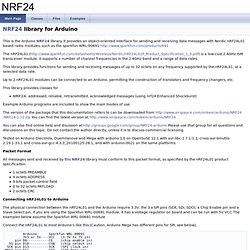
It provides an object-oriented interface for sending and receiving data messages with Nordic nRF24L01 based radio modules, such as the sparkfun WRL-00691 The nRF24L01 ( is a low-cost 2.4GHz ISM transceiver module. It supports a number of channel frequencies in the 2.4GHz band and a range of data rates. This library provides functions for sending and receiving messages of up to 32 octets on any frequency supported by the nRF24L01, at a selected data rate. Up to 2 nRF24L01 modules can be connected to an Arduino, permitting the construction of translators and frequency changers, etc. This library provides classes for NRF24: addressed, reliable, retransmitted, acknowledged messages (using nrf24 Enhanced Shockburst) Example Arduino programs are included to show the main modes of use. The version of the package that this documentation refers to can be downloaded from You can find the latest version at Packet Format. ANT+ Between MSP430 (also Arduino) and Android.
ANT+ what?
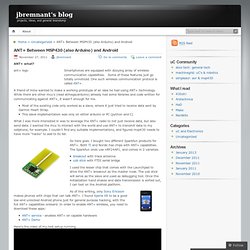
Smartphones are equipped with dizzying array of wireless communication capabilities. Some of these features just go totally unnoticed. One such wireless communication protocol is called ANT+. A friend of mine wanted to make a working prototype of an idea he had using ANT+ technology. While there are other mcu’s (read atmega/arduino) already had some libraries and code written for communicating against ANT+, it wasn’t enough for me. Most of the existing code only worked as a slave, where it just tried to receive data sent by Garmin Heart Strap.This slave implementation was only on either arduino or PC (python and C)